Subscribe by Email
-
Recent Posts
Author Archives: Susan
The Blind Side
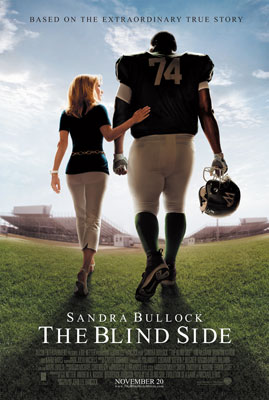
The football movie “The Blind Side” continues to rake in at the box office. At last look, it had passed the $225 million mark and was still going strong, long since its Nov. 20, 2009 release. It’s quite the small-movie phenom of the year, fueled by its amazing and true rags-to-riches story and its evangelical backing. About a big African American kid, one of 12 in his family, whose early years are horrific growing up on the rough side of Memphis, with a crack-addicted mother, and a father he doesn’t know. In and out of foster homes, “Big Mike” is intermittently homeless and sleeping on the couches of acquaintances when he can, one of whom takes him to a private Christian high school, which enrolls him on the athletic coach’s word. On a snowy night, walking back to school in shorts, Mike catches the eye of a rich white family that takes him in and helps him with school and to play football. He comes to play left tackle, protecting the quarterback’s “blind side” with such skill and power, that he draws the attention of college coaches who come clamoring to have him play.
The movie is a feel-good experience, with a wholesome view of the family and life that adopts Mike. Sandra Bullock, as the no nonsense mom who shepherds Mike, and country singer Tim McGraw play the parents. It’s definitely a good, strong character for Bullock, who plays it well. The movie is enjoyable, combining nice family and sports scenes in Mike’s rise out of his circumstances. Though I found it rather sugary, and a bit Disney like, it still is an inspiring a story. It seems Mike is made a bit simplistic in the movie, docile with a low IQ, and parts of the gritty stuff and prejudices seemed airbrushed lightly over. Still the photos of the real people at the end of the movie lend to its strength as a true story; that Mike Oher went on to play offensive tackle this year as a rookie for the Baltimore Ravens is amazing. See this recent New York Times story.
Interesting to note, Oher said he mostly liked the movie but said his character was portrayed as too stupid and his football skills were misrepresented in it though he didn’t elaborate. (He did go on to make the Honor Roll at Ole Miss a couple times.) Oher doesn’t seem to care a lot about the fuss over “Blind Side,” which was based on the 2006 bestselling book by Michael Lewis. Apparently the film’s budget was a mere $29 million, which Sandra Bullock took a pay cut for and agreed instead to receive a percentage of the profits. Seems like a bright idea now. Continue reading
Posted in Movies
Leave a comment
The Road
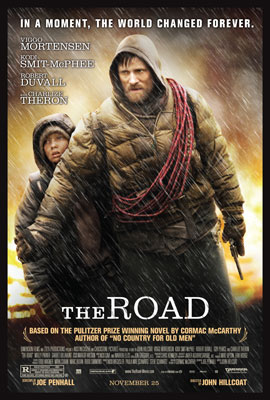
Of course, I had to see “The Road” because of the intriguing Cormac McCarthy book, which won the Pulitzer Prize in 2006. Most seem to know what it’s about: a father and a son trying to survive after some unknown apocalyptical disaster has gutted civilization. The father and boy are on a road going south to the coast, where presumably they might find more food and have a better chance at survival. But along the way there are roving bands of bad guys the father and boy try to avoid, who take prisoners and eat people to get by. It’s a world reduced to savagery and a food-to-mouth existence, where the boy worries if they are still the “good” guys who won’t resort to cannabalism, and his father assures him that they are, that they’re “carrying the fire.”
The movie is a somber affair. The wife, played by Charlize Theron in flashbacks, decides life post-apocalypse isn’t worth living and does herself in before their journey (no great secret if you’ve read the book). Viggo Mortensen, as the father is looking old and scraggily in this, but is excellent as is the boy played by Kodi Smit-McPhee. The cinematography is especially affecting, with scenes of an ashen, dead landscape, where rotting trees split and fall in deafening crescendo, and broken-into cars and houses are left by the wayside. The area around Mount St. Helens serves as a haunting backdrop to the film’s shots of a post-apocalyptic world.
The movie follows the book to a tee. I was sure they would mess with it, but even the ending is like the book’s. Because of the book, I knew where the scary parts would be. The movie seems much more scary than depressing. God the cannibals! You’ll never want to go down into the cellar again. Why does Viggo do it?!&%! Run for Christ sakes!
The Washington Post and L.A. Times pretty much clobbered the movie (the N.Y. Times a bit less so). The Post’s Ann Hornaday called it a “thin, hopelessly mannered story” — “one long dirge … marking the death of hope and the leaching of all that is bright and good from the world.” The L.A. Times’ Kenneth Turan said it was good at horrifying and depressing us but had little else to offer. I thought it faithful to the book and was a pretty affecting tale, a warning of sorts about nuclear annihilation. It reminded me a little of the 1983 TV event, “The Day After.” It also had redemptive qualities in the bonding of the father and son, and in the overall fight between good and the forces of chaos and evil. The struggle to get to the sea and the ending there are subtle but compelling. It might not be an Oscar contender, but “The Road” is no slouch of a movie.
ps. Watch for Robert Duvall as the old nearly blind man they encounter on the road (barely can tell it’s him), and thankfully Guy Pearce comes in at the end. I can’t help but quote from “The Road” these days in asking, “Are you carrying the fire?” Continue reading
Posted in Movies
Leave a comment
The Girl With the Dragon Tattoo
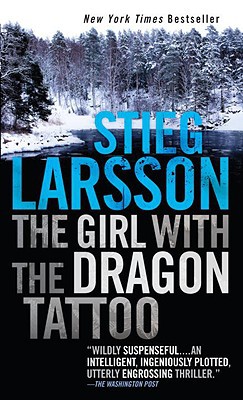
Just picked up the mass paperback and boy is this a quick read — nearly all-842 pages of it. Now I know what all the fuss was about. Apparently Stieg Larsson was the second bestselling author in the world in 2008 (even though he died in 2004) — thanks to his Swedish “Millennium” trilogy, of which “The Girl With the Dragon Tattoo” is the first. The trilogy has sold more than 12.5 million copies, and soon enough I’m sure to pick up book number two. I can’t recall being so consumed by a murder mystery, thriller since perhaps Scott Turow’s “Presumed Innocent” in 1987.
“Girl With the Dragon Tattoo” starts out as protagonist Mikael Blomkvist, a middle-age financial journalist and co-owner of Millennium magazine in Stockholm, hits rock bottom when he’s found guilty in court of libel against shady businessman Hans-Erik Wennerstrom, despite the fact that he knows his story is right but can’t prove it. Exhausted by the case, Blomkvist decides to take time off from the magazine, and accepts an offer from industrialist Henrik Vanger to investigate the disappearance of Vanger’s great-niece 40 years ago from the secluded island that the powerful family owns, three hours by train to the north.
On remote Hedeby Island, Blomkvist finds himself in the depths of winter, trying to make sense of a case long grown cold, and a family that is more than a touch unsettling. The backdrop of the place and the frigid landscape are described vividly enough to make frostbite and darkness feel very real. It might conjure up memories of the 1992 Danish murder mystery “Smilla’s Sense of Snow,” which comes to a head on a glaciated island off of Greenland. Brrr.
Simultaneously, “Dragon Tattoo” also delves into the world of Lizbeth Salander, a 24-year-old pierced, tattooed whip-smart computer hacker whom Blomkvist comes to enlist in time to help crack the case. Salander, who at the beginning is on the verge of being institutionalized for behavioral problems, is a hell of a character, prepared to kick ass and take names later. In a grisly scene, she’s been abused by an appointed guardian and takes it into her own hands to wage a heavy payback.
Blomkvist and Salander make a great investigative combo. Getting to know them in the beginning and middle parts of the book are the best, as new evidence surrounding the creepy Vanger family and disappearance slowly start to emerge. The fact that Blomkvist and Salander start sleeping together while on the case, even though she is half his age, adds an element of complexity (though I don’t think I like it for the characters) with Blomkvist still linked to his partner, Erika Berger, at the magazine. The last part of the book seems to get a bit too tidy with almost all of the pieces falling neatly into place, case cracked, and some of the earlier intrigue losing hold. The ending goes on a tad long and isn’t as good as the rest. But still “Girl With the Dragon Tattoo” proves to be the quickest page-turner of the year.
Ps. A Swedish film of “The Girl With the Dragon Tattoo” came out in 2009 but apparently didn’t get wide release in the States. Catch it if you can. Continue reading
Posted in Books
Leave a comment
A Perfect Getaway

This is sort of one of those crazy summer movies you go to that’s a bit suspenseful and ridiculous but you can’t help liking the scary action all the same. It’s about a couple who celebrate their honeymoon by backpacking to a remote beach on the island of Kauai. Everything seems fine until they hear from some hikers about a double murder of a newlywed couple back in Honolulu and they consider turning back. But they decide to go on and end up joining another couple along the hike whose weirdness in time makes them question if they’re the murderers. Without giving too much away, things get pretty nutty after that. And the ending, itself, is pretty laughable (not sure it makes a lot of sense). But still the action shots of the two athletic couples on the tropical Kauai are hard not to see through. Actor Steve Zahn is the only one I really recognize of the bunch. The film apparently was shot in Jamaica, Puerto Rico and Kauai, and despite all its murderous villainery, makes you want to go hike the tropics after seeing it. Continue reading
Posted in Movies
Leave a comment
The Hurt Locker
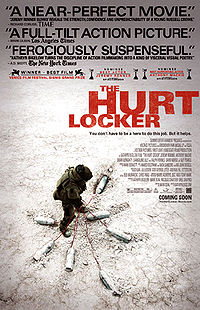
“The rush of battle is a potent and often lethal addiction, for war is a drug,” states a quote from war correspondent Chris Hedges at the beginning of “The Hurt Locker.”
The action-packed war film set in Iraq in 2004 is a hair-raising adrenaline rush that follows three members of Bravo Company’s bomb disposal unit as they work to defuse a series of IEDs, or roadside bombs, in the streets of Iraq, all the while trying not to be picked off by insurgent gunfire.
There’s Spec. Owen Elderidge (Brian Geraghty), who’s a bundle of nerves and seemingly out of his element, and Sgt. J.T. Sanborn (Anthony Mackie), a professional who follows protocols and procedures in the best hope of getting out alive.
Then there’s Staff Sgt. William James (Jeremy Renner), a replacement to the unit’s previous bomb-technician leader who is killed in an explosion. James comes off initially as a cocky bastard considered “reckless” by the others and hell-bent on a death wish. But he also has what it takes to disarm even the most sinister bombs, and in time a more caring side of him comes through.
The film follows the threesome unit as they start a 38-day rotation on a handful of nerve-racking missions, wherein James’s disengaging of bomb wires is undoubtedly the scariest moments to watch. Renner gives a gripping performance as Staff Sgt. James, the risk-taker and adrenaline junkie whose disregard for protocol rubs the others raw.
“The Hurt Locker” is a powerful film due to its authenticity and its script. Written by journalist Mark Boal, who was embedded in Iraq with a bomb squad, and shot close to the Iraq border in Jordan, the film plunges viewers into feeling what war is like, and the risks soldiers take. Except for small roles by Ralph Fiennes and Guy Pierce, the other actors in it are relative unknowns, and don’t distract from the film’s realistic war story and look. I found “The Hurt Locker” quite intense and effective, but for those who don’t care for men and war films, it’s perhaps not meant for everyone. Continue reading
Posted in Movies
Leave a comment
Shutter Island
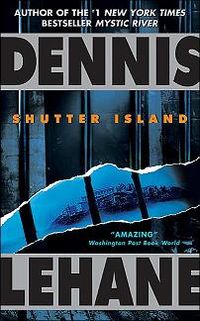
This 2003 suspense novel has one of those twisted endings that make you want to throw it against a wall after you’re done. It seemed to be going along just fine, slowly building in momentum, taking you on a steady course of suspense to its conclusion and then thunk: an ending so opposite of where you want it to go it sets you off to curse that you ever got it.
I had picked up “Shutter Island” because I heard it was coming out as a movie in October 2009 with Leo DiCaprio and directed by Martin Scorsese, and because Dennis Lehane wrote it and his other novels “Gone, Baby, Gone” (1998) and “Mystic River” (2001) became somewhat intriguing movies.
Set in 1954, the story begins as U.S. Marshals Teddy Daniels and Chuck Aule are called to investigate the disappearance of a patient at a hospital for the criminally insane on Shutter Island, off the Massachusetts coast. Daniels, whose beloved wife died in a fire two years prior, has ulterior reasons for taking the case, notably finding the insane criminal housed there who caused her death.
Soon though the deputy marshals find that the medical staff at Shutter Island, especially the director, is stonewalling their investigation, and they discern that radical, illegal treatments are being administered to the patients as part of a secret program. (For other novels on nefarious experimentation taking place on islands, you might also recall: “The Island of Dr. Moreau” (1896), “Dr. No” (1958) and “Plum Island” (1997) to name just a few.)
“Shutter Island” picks up steam as a hurricane hits, cutting off communication to the mainland and enabling more insane patients to escape from their cells. Aule disappears, and Daniels believes he’s being slipped psychotic drugs. He makes a dash to leave the island but is intercepted. As clues unravel, he begins to doubt everything, including his memory, his partner and his sanity.
Lehane gives the book a surreal and really creepy kind of ending, but it’s sort of just lame and leaves you wanting something else. Perhaps they will do better with the movie, which has an all-star cast (even Ben Kingsley and Patricia Clarkson!), and of course, also Scorsese who’s directed “Cape Fear”-freaky-kind of suspense movies before. Continue reading
Posted in Books
Leave a comment
Journalism Above the Fold
Christopher Buckley’s book excerpt “Growing Up Buckley” in the April 26 New York Times Magazine on his parents’ passings is revealing, heartfelt and funny. From his memoir: “Losing Mum and Pup,” the article and book are too good to pass up.
Verlyn Klinkenborg’s “Some Thoughts on the Pleasures of Being a Re-Reader” in the May 30 New York Times is a neat short essay on the refuge that familiar novels bring.
The Los Angeles Times article “The Typist’s Tale of Last Tycoon” by David Ulin about what F. Scott Fitzgerald’s secretary witnessed is fascinating. At 92, Frances Kroll Ring is still alive, and offers a unique glimpse of the great author. For more, check out her 1985 book: “Against the Current: As I Remember F. Scott Fitzgerald.”
Pico Iyer’s op-ed “The Joy of Less” in the June 7 New York Times hits home in a time of recession on the happiness that a simple life brings.
“A Personal Touch in Taliban Fight” by Greg Jaffe in the June 22 Washington Post is a noteworthy portrait of a company commander’s work in the Afghan mountains. Continue reading
Posted in Articles
Leave a comment
The Hangover
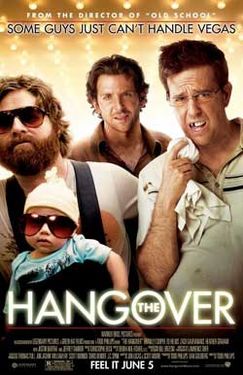
I’m still laughing after seeing this movie about a groom and his three groomsmen who road-trip to Vegas for the bachelor party; whereupon they wake up the next morning not remembering the night before, nor where the groom is, and have to try to retrace their tracks to find him in time for the wedding. The groomsmen share equally pretty funny roles, and even a tiger-owning Mike Tyson makes an appearance.
It’s pretty hysterical and I was quite dubious beforehand, thinking it would be just the same old buddy genre of immature men, bathroom humor and bad taste, without much behind it. But “Hangover” is pleasantly and surprisingly more than that. It’s still crazy, for sure, utterly nutty and far from politically correct, but there’s some substance here and some genuinely funny humor, making it a thoroughly entertaining wild ride — sure to be the summer’s hit for laughs. So get a babysitter, or do what you have to do, and get thee to a theater. You deserve a corrupt break like this.
ps. It’s safe to say the movie gets a strong R rating if you’re wondering about the kiddies etc. Continue reading
Posted in Movies
Leave a comment
Restless
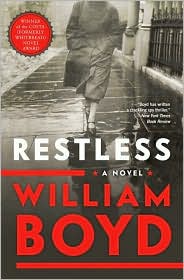
I needed a quick read for a flight and came across William Boyd’s spy novel “Restless,” which did the trick and more. It’s an absorbing thriller about an aging mother, Sally Gilmartin, who thinks her life is in danger and reveals in a series of written accounts to her daughter, Ruth, of her clandestine past — born Eva Delectorskaya, a half-Russian, half-English émigré recruited into the British Secret Service in 1939. Ruth, a single mom and graduate student, thinks at first her mother is going crazy, but is drawn into her account as details of “Eva’s” life emerge.
The story unfolds with chapters alternating between her mother’s life as a spy in 1940-1941 and Ruth’s life in Oxford in 1976, procrastinating her thesis and earning a living teaching English as a second language. Undoubtedly, the chapters of Eva and her work under boss Lucas Romer are more suspenseful, but Ruth’s life also contains a couple of mysterious characters (dubious house guests Ludger and Ilse from Germany and an Iranian suitor Hamid) that keep things up in the air.
Boyd has cleverly based the novel on the history of a covert propaganda group called the British Security Coordination, whose aim was to change the minds of isolationist Americans and lure the U.S. into World War II. In the book, Eva’s work, as part of the secret unit under Romer, includes “feeding clever false information out into the world” through the medium of a small press agency and couriering a forged map of Hitler’s South American ambitions to bait the U.S. into action.
But after a couple missions go badly, Eva realizes someone in her unit has betrayed her and she flees, using her spy training to live life on the run. The BSC unit is rolled up after Pearl Harbor, and Eva (now Sally Gilmartin) marries, keeping her former life hidden.
Thirty-five years later, Sally, still on the lookout for someone who might bring her down, decides to try to put an end to her life undercover by writing her account of the BSC and getting her daughter to track down her former boss.
The 2006 novel, one of the first on the BSC, makes for a snappy, interesting read, conjuring a time in the run-up to WWII when Britain had a secret agency of news manipulation and black propaganda operating right out of N.Y.’s Rockefeller Center.
For more on this hardly heard of agency and the role of British agents in the U.S. before Pearl Harbor, read Boyd’s fascinating article in the Guardian. Continue reading
Posted in Books
Leave a comment
Journalism Above the Fold
New York Times foreign correspondent Dexter Filkins’s essay “Surging and Awakening” in The New Republic on the turnabout of U.S. strategy in Iraq and what it could mean in Afghanistan shouldn’t be missed. Filkins delivered a whopper of a book (“The Forever War”) on U.S. involvement in Iraq and Afghanistan in September 2008, which won a Pulitzer Prize, proving he’s a reporter to follow.
Christopher Goffard’s front-page article “Fleeing All but Each Other” in The Los Angeles Times on the young drifters and runaways who crisscross the country by hopping trains was riveting reading. I could not put down its tragic story of Adam Kuntz and Ashley Hughes and the hard lives of such “traveling kids.”
Vanity Fair’s June article “Hello, Madoff!” on what the Ponzi schemer’s secretary of 20 years witnessed is essential reading, especially for those still trying to figure out how this all happened and what this nutcase was like.
Edward Klein’s book excerpt “The Lion and Legacy” on Ted Kennedy’s battle with brain cancer in the June Vanity Fair is a tough look behind the dilemma. And among other things, it claims Caroline Kennedy pulled out of last year’s N.Y. Senate race because of her kids’ concerns, which she has since dismissed as untrue.
Writer Daphne Merkin’s lifelong battle with chronic depression is heart-wrenchingly captured in her article “A Long Journey in the Dark” in the New York Times Magazine. It’s a tough read but can’t be missed for those hoping she’ll continue to recover. Continue reading
Posted in Articles
Leave a comment
